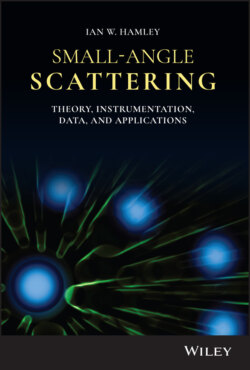Читать книгу Small-Angle Scattering - Ian W. Hamley - Страница 10
Preface
ОглавлениеThis book aims to provide an up‐to‐date and comprehensive account of small‐angle scattering, both small‐angle x‐ray and small‐angle neutron scattering. It discusses both the underlying theory as well as giving practical information and useful examples. The book aims to complement the handful of existing texts in the field but has a broader coverage, not being restricted solely to biological macromolecules or polymers or soft matter. The text is intended to serve two uses. First, it is a ‘go‐to’ reference text as a source of detailed information and essential references for those already working in the field. Second, it should serve as a useful general introduction to the field for the non‐expert. The writing of this text relies on more than 30 years of experience working across the field on many systems and in numerous types of small‐angle scattering experiment, leading teams using many instruments across most major European facilities, as well as lab instruments.
I thank the Synchrotron Radiation Source, Daresbury, for hosting me as a visiting fellow in 2004 and Diamond Light Source for the joint appointment (with the University of Reading) 2005–2010. I would like to thank my PhD supervisors (back in the mists of time) at the University of Southampton, Prof. Geoffrey Luckhurst and Prof. John Seddon, for introducing me to the world of small‐angle scattering. I would like to thank many people with whom I have worked at synchrotron and neutron facilities over the years. The following is an incomplete list (sorry for omissions):
At Risø: Jan Skov Pedersen, Kell Mortensen, Martin Vigild, Wim de Jeu (AMOLF, The Netherlands) and Frank Bates (University of Minnesota, USA), and Jan at Aarhus as well and Frank at NIST also. At SRS Daresbury: Anthony Gleeson, Günter Grossmann, Ernie (Bernd) Komanschek, Liz Towns‐Andrews, Chris Martin, Wim Bras, Tony Ryan, Greg Diakun and Nick Terrill, and many members of my group when at the University of Leeds, especially John Pople and Patrick Fairclough and Tim Lodge (University of Minnesota) for SAS‐related collaboration. At ISIS: Steve King, Richard Heenan, Sarah Rogers, Ann Terry, and James Doutch. At LURE: Claudie Bourgaux. At LPS Université Paris‐sud: Marianne Imperor‐Clerc and Patrick Davidson. At ELETTRA: Heinz Amenitsch. At LLB: Laurence Noirez. At MLZ, Munich: Henrich Frielinghaus and at Oak Ridge National Lab: Bill Hamilton and George Wignall. At the ESRF: Olivier Diat, Pierre Panine, Narayan (Theyencheri Narayanan), Kristina Kvashnina, Daniel Hermida‐Merino, Giuseppe Portale, Petra Pernot, Martha Brennich, Mark Tully, Adam Round, Gemma Newby, and Tom Arnold. At DESY: Sergio Funari and Dmitri Svergun. At the ILL: Peter Lindner and Lionel Porcar. At MaxLab: Tomás Plivelic and at PSI‐Swiss Neutron Source: Joachim Kohlbrecher. At ALBA: Marc Malfois and at SOLEIL: Javier Perez. At Diamond: Nick Terrill, Katsuaki Inoue, Nathan Cowieson, Nikul Khunti, Charlotte Edwards-Gayle, and Rob Rambo. I would also like to especially thank Narayanan Theyencheri (Narayan) from the ESRF for a critical reading and valuable comments on the text. As usual, I take responsibility for any remaining errors and omissions. Biggest thanks go to Valeria Castelletto, who has been a team member/leader at many beamtime sessions – and (perhaps more importantly!) we have also shared our lives for the last 20 years, ‘and it doesn't seem a day too long’.
Ian W. Hamley
University of Reading, UK, 2020
